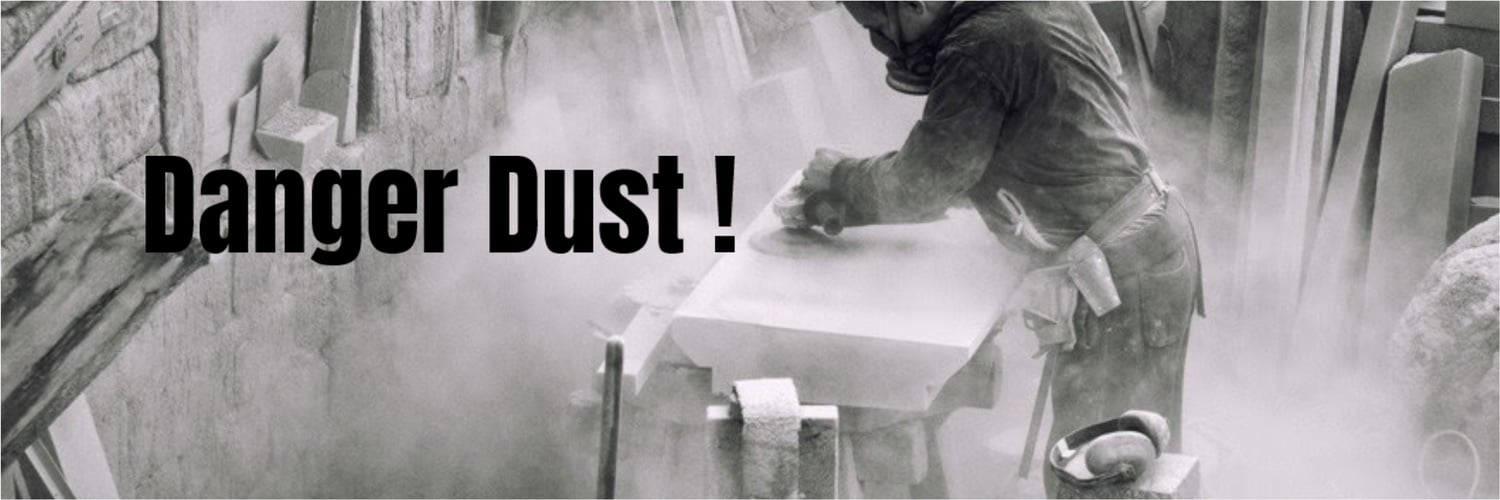
-
Disturbing detail in ‘new asbestos’ concerns
A disturbing detail has been discovered in those most at-risk when in comes to what is being labelled the “new asbestos” that is plaguing the construction and mining industries.
Lung Foundation Australia is exposing the risk of silicosis, which impacts more than 600,000 Aussies in the construction, mining, manufacturing and tunnelling industries.
Silicosis is caused by items with a high silica content such as engineered stone — which has been linked to the incurable illness since 2015. Engineered stone is a common item used in kitchen benchtops but is banned in Australia.
Workers need to be in full protective gear to cut the engineered stone while it’s wet for it to be considered “safe”.
However, a survey of more than 500 people in the most vulnerable industries revealed that only 36 per cent knew what symptoms to look out for.
Symptoms include a persistent cough, shortness of breath and difficulty breathing, which can appear from a few weeks to many years after exposure to silica dust.
A whopping 78 per cent are aware of silica dust and the risk of silicosis but only 23 per cent are worried about developing the lung condition. Only eight per cent have discussed it with a health professional and just 34 per cent understand it’s incurable.
- phys.org It all adds up: Study finds forever chemicals are more toxic as mixtures
A first-of-its-kind study has measured the toxicity of several types of per- and polyfluoroalkyl substances (PFAS), better known as "forever chemicals," when mixed together in the environment and in the human body.
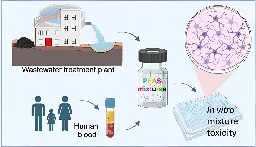
A first-of-its-kind study has measured the toxicity of several types of per- and polyfluoroalkyl substances (PFAS), better known as "forever chemicals," when mixed together in the environment and in the human body.
The good news: Most of the tested chemicals' individual cytotoxicity and neurotoxicity levels were relatively low.
The bad news: the chemicals acted together to make the entire mixture toxic.
The study is novel in that it assesses the mixture toxicity of PFAS. These synthetic compounds have been widely used in consumer products—from nonstick pans to makeup—for decades, and they can take hundreds to thousands of years to break down, if ever. They are estimated to be in at least 45% of the nation's drinking water and in the blood of practically every American, and they have been linked to cancer and neurodevelopmental disorders.
- medicalxpress.com Researchers build first large-scale atlas of how immune cells react to mutations during cancer immunotherapy
A Cleveland Clinic-led research collaboration between Timothy Chan, MD, Ph.D., Chair of Cleveland Clinic's Global Center for Immunotherapy, and Bristol Myers Squibb has published the most comprehensive overview to date of how the immune system reshapes tumor architecture in response to immune checkp...
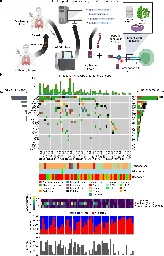
The eight-year study, published in Nature Medicine, outlines how cancer immunotherapy induces tumor recognition through neoantigens to reshape the tumor ecosystem. Neoantigens are small peptides produced when cancer cells mutate and are a primary marker for the immune system to recognize cancer cells as different from self.
Neoantigens are thought to be the primary way that the immune system recognizes tumors, but neoantigen prediction tools lack accuracy due to a lack of existing data in this space. To overcome this issue, the team developed the largest neoantigen screen to date, where they validated their predictions and monitored the dynamic response to neoantigens with longitudinal blood draws.
Within three weeks of treatment, people who went on to respond well to nivolumab had a sharp decline in clonal neoantigens. Meanwhile, individuals whose cancer did not go into remission still mounted an immunologic response, but to smaller sub-clonal populations. This is important because many believed that non-responders were unable to activate and recognize the tumor, but here they show it may be that the immune system is mounting a response to neoantigens but that this is insufficient to destroy all tumor clones.
-
Association between silicosis and autoimmune disease
Purpose of review
There is a well established association between silica inhalational exposure and autoimmune disease, particularly in the context of intense exposure. We will provide in this article an update overview of new sources of silica dust exposure, with evidences of mechanisms from human and animal studies for association between silica and autoimmune diseases, their early detection of silicosis and new options for treatment.
The association between silica exposure and autoimmune disease was first described by Bramwell in 1914, who observed scleroderma among stone masons .
Fifty years later, Erasmus found an increased incidence of systemic sclerosis (SSc) among South African gold miners, later referred to as Erasmus syndrome .
In 1952, Caplan described the occurrence of multiple lung nodules in coal miners who suffered from rheumatoid arthritis (RA), comorbidity known as Caplan's syndrome or rheumatoid pneumoconiosis.
Significant risk of developing SSc, RA, systemic lupus erythematosus (SLE), dermatomyositis/polymyositis and antineutrophil cytoplasmic antibody-positive vasculitis has been linked to silica exposure and a study demonstrates that male patients with SSc have a high prevalence of occupational exposure to silica or solvents.
-
The EU has banned animal testing for cosmetics and non-animal alternative methods are preferable for the risk assessment of new chemical substances.
At the Fraunhofer Institute for Interfacial Engineering and Biotechnology IGB, a three-dimensional skin model has now been set up for the first time that directly displays the skin's reaction to substances: The reporter skin.
Thanks to the built-in reporter, the cellular response can be measured precisely and quickly – using a living model. This means that not only cosmetics can be tested effectively, but also allergens and the inflammation-causing or toxic effects of biocides, pesticides and chemicals.
- knowablemagazine.org Handing the surgeon’s scalpel to a robot
After decades of merely assisting doctors, are sophisticated machines ready to take charge?

After decades of merely assisting doctors, are sophisticated machines ready to take charge?
Robots have been found in the operating suite since the 1980s for things like holding a patient’s limbs in place, and later for laparoscopic surgery, in which surgeons can use remote-controlled robot arms to operate on the human body through tiny holes instead of huge cuts. But for the most part these robots have been, in essence, just very fancy versions of the scalpels and forceps surgeons have been using for centuries — incredibly sophisticated, granted, and capable of operating with incredible precision, but still tools in the surgeon’s hands.
Despite many challenges, that is changing. Today, five years after that award announcement, engineers are taking steps toward building independent machines that not only can cut or suture, but also plan those cuts, improvise and adapt. Researchers are improving the machines’ ability to navigate the complexities of the human body and coordinate with human doctors. But the truly autonomous robotic surgeon that the military may envision — just like truly driverless cars — may still be a long way off. And their biggest challenge may not be technological, but convincing people it’s OK to use them.
- www.primenewsghana.com Cost-effective alternatives to construction today
The challenge of providing affordable housing to the majority of citizens is a pressing issue in many countries, particularly in Ghana. The soaring prices of homes can be largely attributed to the rising costs of building materials.

The challenge of providing affordable housing to the majority of citizens is a pressing issue in many countries, particularly in Ghana. The soaring prices of homes can be largely attributed to the rising costs of building materials.
Below, are some alternatives that can potentially lower the cost of construction while ensuring sustainability and efficiency.
- www.nfuonline.com NFU expert advises on occupational health and safety in agriculture
We've summarised the risks and training opportunities to help farmers avoid long-term illnesses as a result of working in agriculture.
Occupational health and safety in agriculture
An average of 12,000 people suffer with work related ill heath in agriculture.
Illnesses can range from respiratory diseases such as:
-
Farmers lung, from exposure spores from mouldy grain, hay, and straw.
-
Silicosis, from exposure to silica dust.
-
Asthma, from exposure to dust – agriculture has the highest incident rate compared to occupational rates in other industries.
-
Asbestosis, from exposure to asbestos.
-
- phys.org Brazilians choke as fire smoke blankets 80% of country
With as much as 80 percent of Brazil under a blanket of smoke from historic wild fires, face masks last used during the coronavirus pandemic are coming out again.

With as much as 80 percent of Brazil under a blanket of smoke from historic wild fires, face masks last used during the coronavirus pandemic are coming out again.
South America's biggest country has for weeks been choking on pollution along with much of the rest of the continent battling extreme drought and record fires.
Millions of hectares of forest and farmland have burnt in Argentina, Brazil, Bolivia, Colombia, Ecuador, Paraguay and Peru.
The Amazon basin, usually one of the wettest places on Earth, is experiencing its worst fires in nearly two decades, according to the EU's Copernicus observatory.
Air pollution can worsen bronchitis and asthma, and the risk is greater the longer the exposure.
- phys.org Developing artificial muscles to give weakened people their strength back
Researchers have succeeded in making artificial muscle fibers from rubber thread, paving the way for sewing the muscles into a blouse and giving renewed strength to the wearer.

Researchers have succeeded in making artificial muscle fibers from rubber thread, paving the way for sewing the muscles into a blouse and giving renewed strength to the wearer.
"I know it doesn't look like a lot, but it corresponds to what our own muscles can lift," says Anne Ladegaard Skov, Professor at DTU Chemical Engineering.
Together with her research team, she has designed the silicone thread with a cavity which a conductive liquid can run through. Just like when the brain sends an electrical signal to the body's muscles to activate, the researchers can send current through the artificial muscle fibers via the conductive fluid and cause them to contract.
When this happens, they can lift 200 times their own weight. They thus have the potential to make life easier for millions of people with impaired muscle function.
- medicalxpress.com COVID-induced immune memory could protect against severe cases of flu, mouse study suggests
More than 200 viruses can infect and cause disease in humans; most of us will be infected by several over the course of a lifetime. Does an encounter with one virus influence how your immune system responds to a different one? If so, how? Does it weaken your defenses, boost them, or have some other ...
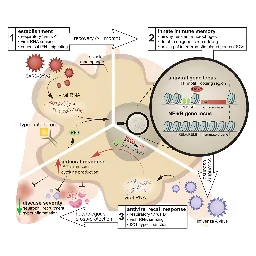
By analyzing mice that had been first infected with SARS-CoV-2 and then with influenza A virus, the scientists found that having recovered from COVID had a protective effect against the worst effects of the flu, and that this memory response was coming from an unexpected corner of the immune system.
It turned out that epigenetic changes in macrophages—innate immune cells that are among the first responders to a threat—had developed a kind of "memory" following COVID that allowed these cells to mount a better defense against an unrelated virus. Immunological memory has long been thought to be limited to adaptive immune cells, though recent work has challenged this dogma. More intriguingly, what macrophages were remembering wasn't unique to any particular virus.
The findings increase our understanding of innate immune memory and may enable researchers to exploit the phenomenon in new ways to create therapies that confer widespread protection against multiple viruses.
-
Fungal infections known as valley fever could spike this fall - 3 epidemiologists explain how to protect yourself
theconversation.com Fungal infections known as valley fever could spike this fall - 3 epidemiologists explain how to protect yourselfCases of valley fever are typically most prevalent in California’s Central Valley and southern Arizona, but they have been increasing in California’s central and southern coastal areas.

What are the symptoms, and what should people be looking for?
After inhaling fungal spores from the environment, Coccidioides initially infects the lungs, causing symptoms like mild to severe cough, fever, difficulty breathing, chest pain and tiredness. Valley fever symptoms can resemble other common respiratory infections, so it’s important for people to get checked by a doctor if they’ve experienced prolonged symptoms, particularly if they have been given antibiotics that they are not responding to.
In California and Arizona, an estimated one-third of community-acquired pneumonia cases – or pneumonia acquired outside of the hospital – are caused by valley fever.
- www.nature.com A rapid point of care CC16 kit for screening of occupational silica dust exposed workers for early detection of silicosis/silico-tuberculosis | Scientific Reports
Silicosis is an irreversible, incurable and progressive occupational disease caused by prolonged exposure to crystalline-silica dust while working in the relevant industries. Conventionally diagnosis is done by chest radiology, often in an advanced stage as early symptoms often go unnoticed. Early d...
In conclusion, it may be said that this Point of Care kit may be employed for semi-quantitative estimation of CC16 in human serum samples for the selective population (having a history of occupational silica dust exposure). The inverse relationship between serum CC16 levels and the severity of silicosis has already been evidenced in the previous studies performed by ICMR-NIOH
The individuals exhibiting three bands in LFA (CC16 concentration > 9 ng/ml) need not go for X-ray. This can significantly decrease the risk of X-ray exposure to the individuals. Hence, this assay would be useful for early detection of silicosis for various purposes such as notification to the local authority, secondary prevention and financial compensation as per guidelines of the country.
- theconversation.com Breathing may introduce microplastics to the brain – new study
Eight out of the 15 brains studied had microplastics in their olfactory bulbs.

For a long time, it was thought that the human brain existed in splendid isolation from the rest of the body. The so-called blood-brain barrier, a special layer of cells, protects the brain from all manner of pathogens and harmful substances. However, we now know that the blood-brain barrier can be breached because small plastic particles have been found in the human brain.
New research has suggested that the blood-brain barrier has at least one vulnerable spot where microplastics may be able to get into the brain. This potential entry point was suggested by researchers at the Freie Universität Berlin and the University of São Paulo. It is in the nose, where there are special nerves, the olfactory nerves, that detect smells.....
Eight out of the 15 brains studied had microplastics in their olfactory bulbs. However, these eight samples had only 16 microplastic particles between them, which is perhaps some comfort.
Those 16 plastic particles included fragments, spheres and fibres, and were made of polypropylene, nylon and other plastics. Some of the fibres could have come from clothing. This makes sense because laundering clothes made from synthetic fibres is a significant source of microplastics in the environment.
-
Erasmus Syndrome: A Case Series of Rare Co-Occurrence of Silicosis and Systemic Sclerosis
Erasmus syndrome is the association of silica exposure and subsequent development of systemic sclerosis.
Here we discuss five cases that presented with progressive shortness of breath, arthralgia, skin tightening, and Raynaud's phenomenon. History of exposure to silica dust was present in all cases, and further serological (Anti-Scl-70 antibody positive), radiological, and histopathological (skin biopsy) investigations confirmed the diagnosis of systemic sclerosis. Hence the diagnosis of Erasmus syndrome was made.
Therefore, careful screening should be done in patients of silicosis with systemic symptoms to rule out any associated connective tissue disorder. Timely diagnosis and early intervention can prevent the patients from developing life-threatening complications and improved quality of life.
-
Company misled investors on possible Alzheimer’s drug, SEC charges
The troubled biopharma company Cassava Sciences agreed last week to pay $40 million to settle U.S. Securities and Exchange Commission (SEC) charges that it had misled investors about early clinical results for its experimental Alzheimer’s disease drug, simufilam. The compound is now in pivotal phase 3 trials, but SEC’s announcement may fuel calls to halt those studies.
SEC’s moves follow Wang’s recent indictment by the U.S. Department of Justice for alleged research fraud in laboratory work associated with simufilam, which Wang and Burns invented. The Food and Drug Administration (FDA) had identified a raft of serious deficiencies in Wang’s lab procedures, strongly suggesting some tests he ran on simufilam clinical trial samples were invalid. CUNY itself found Wang had committed “egregious” scientific misconduct associated with his work for Cassava and other studies.
The SEC complaint said Cassava and Barbier knew Wang’s lab was not qualified to conduct the biomarker testing that suggested simufilam was effective for Alzheimer’s, among other problems. The agency also charged that Wang had been “unblinded” for patient fluid samples that he tested. That means he would have known which samples came from those given the drug rather than a placebo, potentially biasing his data.
- www.sciencealert.com Our Atmosphere Transforms Dust From The Sahara Into Minerals That Fuel Life
Everything’s connected.

Dust swept from the Sahara desert provides life at the bottom of the marine food chain with a critical nutrient. Without the iron carried far and wide in this mineral cloud, oceanic phytoplankton would struggle to bloom.
Source:
Long-range transport of dust enhances oceanic iron bioavailability
https://www.frontiersin.org/journals/marine-science/articles/10.3389/fmars.2024.1428621/full
- www.frontiersin.org Frontiers | Microplastics in sea surface waters in the Southern Bight of the North Sea
Microplastic pollution in the marine environment is of concern, with evidence of harmful effects on marine biota and ecosystems. There is still a knowledge g...
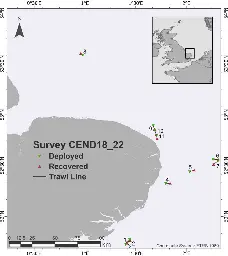
Microplastics were detected in all the samples under investigation, suggesting a widespread occurrence of microplastics in the Southern Bight of the North Sea. The highest abundance of microplastics was reported off the coast of East Anglia; however, the concentrations were lower compared to other locations globally. Fragments were the main prevalent (78%) morphology of microplastics followed by beads (8%), filaments (6%), and films (6%).
This suggests that the microplastics in UK waters mainly break down from larger items such as bags, bottles, and food containers. The adoption of surface water as a common indicator for microlitter for OSPAR environmental assessments would allow for future studies at a regional level to allow for regional action plans and risk maps. This work and data are also important at the global level to feed into and help advance the SDG indicator 14.1.1 on Plastic Litter in the Ocean.
Smaller items (smaller than 300 mm) are potentially under-sampled in surface water when they are smaller than the mesh size such as the small pink beads from cosmetics.
- www.abc.net.au Millions of tons of surplus food is wasted every year. Could a tax incentive push producers to donate more?
Mountains of food is wasted every year in Australia, while at the same time there's been a doubling in the need for food relief. Now, there is a push on to incentivise companies to donate more.

In short:
Foodbank says millions of tonnes of food is wasted every year in Australia, while at the same time there's been a doubling in the need for food relief.
A tax incentive has been proposed that would give farmers and manufacturers the ability to claim some of the expenses involved in food donations.
What's next?
The food tax bill is due to go before the Senate later this year. If passed, the incentive would be available for three years in the hope cost of living pressures will have eased by then.
- theconversation.com Workplace wellbeing programmes often don’t work – but here’s how to make them better
Programmes rooted in positive psychology may be one way to help all employees get something out of workplace wellbeing initiatives.

Motivation
Organisations often opt for easy-to-implement initiatives, such as hosting wellbeing talks or offering mindfulness or yoga classes. They then complain that employees don’t attend or don’t appreciate them.
Many employees say they don’t attend these activities because they find them irrelevant, unhelpful or they don’t value them enough to attend – meaning their workplace has failed in identifying their needs.
- www.psychologytoday.com Long COVID, Depression, and the Immune System
The risk of COVID might have lessened, but long COVID remains a worry for many people. Researchers are looking for risk factors for long COVID, and depression may just be one.

A possible marker for the risk of developing long COVID.
Key points
-
The risk of developing long COVID is low, but the consequences can be severe.
-
Pre-existing conditions like anxiety, depression and loneliness can all increase risk.
-
The role of depression and other psychological issues in long COVID is worthy of further investigation.
Depression and your immune system
One of these comorbidities that appears to increase the risk of long COVID is depression. It might seem somewhat odd that a problem associated with having long COVID is also a predictor of long COVID, but there is good reason to suspect that depression might be an important precursor. That is because clinical depression, even without the added complication of COVID, can and does impair the functioning of the immune system. It makes sense that a virus that compromises the immune system might have a more lasting effect on the body if that immune system is already weakened by depression.
-
-
Patient Enrollment to Industry-Sponsored Versus Federally Sponsored Cancer Clinical Trials
Conclusion
In the United States, there is a growing reliance on industry to conduct cancer clinical research. Underinvestment in federally sponsored research comes at a cost for both patients and researchers, with lost opportunities for scientific, clinical, and population advances.
Our study demonstrates that the landscape of clinical cancer research in the United States is shifting toward one dominated by industry.
This has policy implications since industry sponsors focus predominantly on drug and biological agent interventions, whereas federally sponsored trials are more inclusive of different combinations of agents and modalities and are more oriented toward research questions important for a diverse population of patients.
These different models for cancer clinical research both serve vital functions in new treatment discovery and are, ultimately, complementary.
Nonetheless, an underinvestment to the main avenues for federally supported clinical research is occurring at a time when such research is greatly needed to perform the trials that industry will not do.
Thus, policymakers should aim to address the increasing imbalance between industry and federally funded cancer clinical research to benefit both researchers and patients in terms of scientific, clinical, and population advances.
- www.medievalists.net Medieval Remedies for Modern Ailments: Can a 14th-Century Text Reshape Healthcare? - Medievalists.net
Amid growing health concerns over chronic conditions like diabetes and cardiovascular disease, modern researchers are increasingly looking to the past for innovative solutions. A new study examines what a 14th-century text reveals about 'food as medicine'.
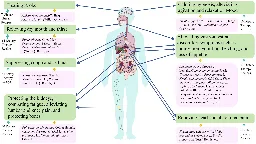
A team of Chinese and Mongolian researchers has examined a work known as Yinshan Zhengyao, written in 1330 by Hu Sihui, the Yuan Dynasty’s Imperial Dietician. This extraordinary text, which the researchers dub “the first nutritional science treatise in the world,” offers a philosophy on managing one’s diet for preventive health. It is followed by over 200 recipes for soups and elixirs and details 232 foods and 174 medicinal plants, highlighting their usefulness and benefits to well-being. Hu Sihui incorporated a wide variety of dietary and medical knowledge from Chinese, Mongol, and Arab sources for his work.
The researchers hope that this medieval source can offer new insights into the ancient concept of using food to treat ailments, bolstered by modern knowledge of genetics and metabolism to bring the teachings of Yinshan Zhengyao back into the public eye.
-
Chlorine trifluoride is an interhalogen compound with the formula ClF3. This colorless, poisonous, corrosive, and extremely reactive gas condenses to a pale-greenish yellow liquid, the form in which it is most often sold (pressurized at room temperature). Despite being famous for its extreme oxidation properties and igniting many things, chlorine trifluoride is not combustible itself. The compound is primarily of interest in plasmaless cleaning and etching operations in the semiconductor industry, in nuclear reactor fuel processing, historically as a component in rocket fuels, and various other industrial operations owing to its corrosive nature.
This oxidizing power, surpassing that of oxygen, causes ClF3 to react vigorously with many other materials often thought of as incombustible and refractory.
It is known to ignite sand, asbestos, glass, and even ashes of substances that have already burned in oxygen. In one particular industrial accident, a spill of 900 kg of ClF3 burned through 30 cm of concrete and 90 cm of gravel beneath.
There is exactly one known fire control/suppression method capable of dealing with ClF3—flooding the fire with nitrogen or noble gases such as argon. Barring that, the area must simply be kept cool until the reaction ceases. The compound reacts with water-based suppressors and CO2, rendering them counterproductive.
Exposure to larger amounts of ClF3, as a liquid or as a gas, ignites living tissue, resulting in severe chemical and thermal burns. ClF3 reacts violently with water and exposure to the reaction also results in burns. The products of hydrolysis are mainly hydrofluoric acid and hydrochloric acid, which are usually released as steam or vapor due to the highly exothermic nature of the reaction.
- www.ccohs.ca What are the Effects of Dust on the Lungs?
What are the lungs? The lungs are the organs of breathing: they are responsible for bringing oxygen from the atmosphere into the body through a series of branching air tubes (Figure 1) and exchanging it for carbon dioxide that is released back into the atmosphere.

The lungs are constantly exposed to danger from the dusts we breathe. Luckily, the lungs have another function - they have defence mechanisms that protect them by removing dust particles from the respiratory system. For example, during a lifetime, a coal miner may inhale 1,000 grams of dust into their lungs. When doctors examine the lungs of a miner after death, they find no more than 40 grams of dust. Such a relatively small residue illustrates the importance of the lungs' defences and certainly suggests that they are quite effective. On the other hand, even though the lungs can clear themselves, excessive inhalation of dust may result in disease.
Dusts are tiny solid particles scattered or suspended in the air. The particles are "inorganic" or "organic," depending on the source of the dust. Inorganic dusts can come from grinding metals or minerals such as rock or soil. Examples of inorganic dusts are silica, asbestos, and coal.
Organic dusts originate from plants or animals. An example of organic dust is dust that arises from handling grain. These dusts can contain a great number of substances. Aside from the vegetable or animal component, organic dusts may also contain fungi or microbes and the toxic substances given off by microbes. For example, histoplasmosis, psittacosis and Q Fever are diseases that people can get if they breathe in organic that are infected with a certain microorganisms.
Dusts can also come from organic chemicals (e.g., dyes, pesticides). However, in this OSH Answers document, we are only considering dust particles that cause fibrosis or allergic reactions in the lungs. We are not including chemical dusts that cause other acute toxic effects, nor long term effects such as cancer for example.
- earthobservatory.nasa.gov How Dust Affects the World’s Health
NASA research finds that a combination of windblown dust and human-caused particle pollution was associated with nearly 3 million premature deaths in 2019.
The NASA team’s conclusion: exposure to PM2.5 likely contributed to 2.89 million premature deaths in 2019—1.19 million from heart disease, 1.01 million from stroke, 287,000 from COPD, 230,000 from lower respiratory infection, and 166,000 from lung cancer. According to their estimates, roughly 43 percent of those deaths occurred in China and 23 percent in India—two of the most populous and polluted countries in the world. Other countries with significant exposure to PM2.5 and large numbers of premature deaths included Pakistan, Bangladesh, and Nigeria—though none of these countries accounted for more than three percent of the total deaths linked to PM2.5.
The analysis linked 22 percent of the premature deaths associated with PM2.5 to dust—much of this in a “dust belt” that spans from West Africa to East Asia.
- theconversation.com Pink cocaine: the party drug cocktail putting a growing number of lives at risk
Pink cocaine, an unpredictable and dangerous synthetic drug, is rapidly gaining traction on Europe’s party scene.
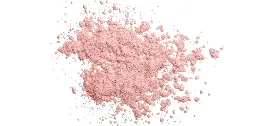
Despite its name, pink cocaine doesn’t necessarily contain any cocaine. Instead, it’s often a mixture of various other substances, including MDMA, ketamine and 2C-B. MDMA, commonly known as ecstasy, is a stimulant with psychedelic properties while ketamine is a powerful anaesthetic which has sedative and hallucinogenic effects. 2C drugs are classed as psychedelics but they can also produce stimulant effects.
The original psychedelic form of the drug dates to 1974 and was first synthesised by American biochemist, Alexander Shulgin. But the modern variant emerged around 2010 in Colombia and is a knock-off version.
The drug gained popularity on the party scene in Latin America and has now spread to Europe. Common names for pink cocaine vary widely, from “cocaina rosada” and “tuci” to “Venus” and “Eros”.
Russian roulette
Today’s pink cocaine is an unpredictable mix of substances and that is where much of its danger lies. Users often expect a stimulant similar to cocaine, but the inclusion of ketamine can lead to serious health risks. Abuse of ketamine, which is widely available as a club drug, can lead to unconsciousness or dangerously laboured breathing. This in turn increases the potential dangers of pink cocaine.
Its aesthetic look and “designer drug” status have contributed to its appeal, particularly among young people and first-time users. This mirrors the historical allure of drugs like cocaine and MDMA. It highlights a persistent trend where certain substances are glamourised despite their risks.
Experts compare taking pink cocaine to playing Russian Roulette with substance use, underscoring the unpredictable and dangerous nature of pink cocaine.
The drug has spread beyond Ibiza to the UK, and there is evidence that it has gained traction in Scotland, parts of Wales and England. Across the Atlantic, New York City has also seen a surge in its availability.
-
Air pollution and breast cancer risk – a link that calls for political action
Professor Charles Swanton, the Francis Crick Institute, London, UK, whose research suggesting how PM2.5 particles may trigger lung cancer in non-smokers was presented at ESMO Congress 2022, stressed the importance of the new findings with breast cancer.
“These very small particles can penetrate deep into the lung and get into the bloodstream from where they are absorbed into breast and other tissues. There is already evidence that air pollutants can change the architecture of the breast.
- www.hse-network.com The Link Between Mental Health, Drugs and Alcohol use in Construction - HSE Network
Here we revisit out our podcast with Andy Stevens, looking at the link between mental health, drugs and alcohol use in construction.
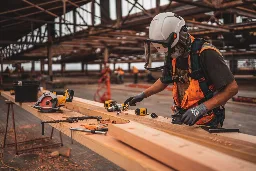
The Silent Struggle
Mental health problems are more widespread than commonly acknowledged, affecting approximately one in four individuals in the UK annually. This significant statistic highlights the urgent need to recognise and address the mental health challenges faced by employees. Andy Stevens, an entrepreneur with extensive experience in the construction industry, has shared his own struggle with complex PTSD, anxiety, and depression, which was only diagnosed six years ago. This is a stark reminder that mental health concerns can be concealed beneath a facade of normalcy, emphasising the importance of candid conversations about these issues. It is critical that organisations prioritise mental health support for their employees, promoting a culture of openness and mutual support.
The Relationship Between Mental Health and Substance Use
The correlation between mental health issues and substance use, such as drugs and alcohol, is a noteworthy aspect of the ongoing discourse on mental health. In the construction industry, for instance, Andy Stevens observes that mental health challenges and substance use often coincide. The prevalent culture of alcohol consumption or casual drug use can provide an easy escape for those grappling with the stress and emotional turmoil that accompany mental health issues.
- www.nature.com Evidence for widespread human exposure to food contact chemicals | Journal of Exposure Science & Environmental Epidemiology
Over 1800 food contact chemicals (FCCs) are known to migrate from food contact articles used to store, process, package, and serve foodstuffs. Many of these FCCs have hazard properties of concern, and still others have never been tested for toxicity. Humans are known to be exposed to FCCs via foods,...
Background
Over 1800 food contact chemicals (FCCs) are known to migrate from food contact articles used to store, process, package, and serve foodstuffs. Many of these FCCs have hazard properties of concern, and still others have never been tested for toxicity. Humans are known to be exposed to FCCs via foods, but the full extent of human exposure to all FCCs is unknown.
Impact statement
We present systematically compiled evidence on human exposure to 3601 food contact chemicals (FCCs) and highlight FCCs that are of concern because of their known hazard properties. Further, we identify relevant data gaps for FCCs found in food contact materials and foods. This article improves the understanding of food contact materials’ contribution to chemical exposure for the human population and highlights opportunities for improving public health.
In summary, this study systematically maps 3601 chemicals from different FCAs (food packaging, tableware, etc.) for which there is evidence for human exposure, and for 10,786 FCCs, no evidence could be provided at all. Only 15 FCCs have been monitored but have never been detected in humans. Based on two subsets totalling 410 FCCs, this study further identifies 105 FCCs of high concern due to their hazard properties and highlights the many data gaps related to hazards and human health risks.
- theconversation.com Ketamine: what you need to know about the UK’s growing drug problem
More and more people are seeking medical help for problems related to ketamine use.

Ketamine typically takes about 15 minutes to work and induces euphoria, relaxation and a slight sense of detachment. However, with higher doses it can also cause dissociation. This can be confusing and can cause panic attacks and memory loss. It can increase blood pressure and affect breathing and heart function.
Effects can also be fatal.
Some urologists have also expressed concern about an increase in bladder problems (so-called “ketamine bladder”) as a result of prolonged and heavy use of the drug. Although national data about the number of people with ketamine bladder is not available, there are other sources about the use of ketamine.
Ketamine doesn’t induce the same type of hangover that alcohol and other drugs do. This makes it appealing to those who need to be at work the day after using it. Likewise, it is appealing to those on zero-hour contracts who are asked to work at short notice.
However, many people will use other substances alongside ketamine – typically alcohol. Mixing alcohol and ketamine can cause significant harm, ranging from slowed breathing to coma and even fatal overdose.
Paradoxically ketamine is being investigated as a treatment for those who are dependent on alcohol, including those who haven’t responded to more traditional forms of therapy.
It’s not clear whether the UK has reached peak ketamine use. Most drugs fall in and out of fashion. It is clear that originally banning the drug in 2005, and increasing punishments in 2014 has failed to halt its rising popularity. What could have helped was investment into prevention, education and harm reduction services, but this didn’t happen and we are seeing some of the consequences now.
-
Centrality of Myeloid-Lineage Phagocytes in Particle-Triggered Inflammation and Autoimmunity
A prototypical example is occupational exposure to respirable crystalline silica, which is etiologically linked to systemic lupus erythematosus (SLE) and other human autoimmune diseases. Silica-induced immunogenic cell death and danger signal release triggers accumulation of T and B cells, along with IgG-secreting plasma cells, indicative of ectopic lymphoid tissue neogenesis, and broad-spectrum autoantibody production in the lung. These events drive early autoimmunity onset and accelerate end-stage autoimmune glomerulonephritis.
-
Renal involvement in a silicosis patient – case report and literature review
Occupational exposure to silica or silicon dioxide dust has been examined as a possible risk factor with respect to several diseases, like tuberculosis, lung cancer, systemic vasculitis , rheumatoid arthritis, systemic sclerosis , systemic lupus erythematosus , renal involvement , etc.
Early in 1951, Saita G et al.firstly reported that the renal functions were decreased in some silicosis patients. Subsequently, several epidemiological evidences suggested that the silica exposure was associated with an increased risk of end-stage renal disease (ESRD), chronic kidney disease (CKD), or specifically glomerulonephritis.
Silica nephropathy referred to the floorboard of kidney diseases after exposure to silica or silicon dioxide, including tubulo-interstitial disease, immune-mediated disease, chronic kidney disease, and end-stage renal disease. In literatures, the renal histopathology of silica nephropathy was varied, including focal glomerureview ritis, necrotizing glomerulonephritis, crescentic glomerulonephritis, etc.
-
Non-invasive electroencephalography in awake cats: Feasibility and application to sensory processing in chronic pain
In a world first, veterinary scientists at Université de Montréal have found a way to scan the brains of cats while they're awake, using electrodes concealed under specially knitted wool caps.
Highlights
• Electroencephalography (EEG), using surface electrodes, allowed non-invasive recording of brain activity in conscious cats.
• Event-related potentials following mechanical and olfactory stimulations were identified in awake cats using EEG.
• Visual stimulations correlated with EEG spectral signatures, showed distinct patterns across different light wavelengths.
• This method allows to study brain activity in animals affected by chronic pain and its modulation with sensory stimulation.
Chronic pain associated with radiographic osteoarthritis (OA) affects 25.6 % of the adult feline population and this incidence increases with age .
Electroencephalography recording in awake cats was well-tolerated and enabled the identification of ERPs following RMTS and olfactory stimulations.
Considering the OA neuroplastic changes, and the possibility of recording and analysing EEGs, this makes them a non-invasive diagnostic tool of choice and this method opens new avenues for improving animal welfare. It could be used to objectively measure sensory hypersensitivity in OA cats using ERPs, and to determine pain modulation using spectral analysis.
-
Dust suppression’s role in preventing Silicosis
Wet spraying systems are among the most effective dust suppression methods, particularly in industries where dust generation is a significant concern. These systems are vital in mitigating airborne particles, including hazardous respirable crystalline silica, which can cause silicosis.
Silicosis is an irreversible and potentially fatal lung disease caused by prolonged exposure to fine silica dust, commonly found in industries such as mining, construction, and manufacturing. Wet spraying systems not only help in safeguarding workers' health but also assist businesses in complying with strict environmental and safety regulations.
Wet spraying systems work by using water or a mixture of water and chemicals to suppress dust particles before they become airborne. The basic principle involves spraying fine droplets of water over dust-generating areas to bind with the particles. As the water droplets collide with the dust particles, they form heavier aggregates that fall to the ground rather than floating in the air. This reduces the concentration of dust particles, particularly those smaller than 10 microns in diameter, which are most harmful when inhaled.
- phys.org How to save a sinking city
What do Venice, Jakarta, Manilla and Bangkok have in common? They are or were sinking cities. Wageningen researcher Philip Minderhoud studies the causes of subsidence in these cities. Groundwater extraction plays an important part in all cases. The good news is that this can be avoided.

The best-known example of a sinking city is Jakarta. Large sections of the Indonesian city have dropped by three to four meters since the '80s, and continue to do so by up to ten centimeters annually. Some 40% of the city is below sea level, prompting the Indonesian government to move the capital to Kalimantan.
Sinking cities are mainly the result of groundwater extraction, says Minderhoud. Tragically, in the case of Jakarta, this cause has been ignored for many years.
The fact that water extraction delivers clean drinking water and drives economic development, and as such, benefits many may have contributed, although it is technically simple to stop extracting groundwater, doing so is a socioeconomic challenge.
- medicalxpress.com Study offers potential for early diagnosis and therapeutic intervention for rheumatoid arthritis
Currently, there are no cures for rheumatoid arthritis (RA), which affects 40,000 people in Ireland. The disease costs an estimated $22,000 per patient, per year with an overall cost to the health system of ~$608 million. Only 1 in 4 patients achieve remission and a significant proportion of patient...
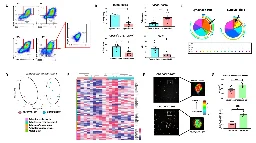
Currently, there are no cures for rheumatoid arthritis (RA), which affects 40,000 people in Ireland. The disease costs an estimated $22,000 per patient, per year with an overall cost to the health system of ~$608 million. Only 1 in 4 patients achieve remission and a significant proportion of patients have suboptimal responses or no response at all to current available therapies.
As it is impossible to predict who will develop severe, erosive disease and who will respond to treatment, a trial-and-error approach prevails, leading to potential irreversible joint damage before the patient has received the correct treatment.
The team performed an in-depth investigation of a specific population of cells: the macrophages that reside in the synovium of RA patients, individuals-at-risk of RA, and healthy controls. Researchers demonstrated, for the first time, the presence of a dominant macrophage subtype (CD40-expressing CD206+CD163+) in the inflamed RA synovium, which importantly was associated with disease-activity and treatment response.
Combined, these findings identify the presence of an early pathogenic macrophage cell/gene signature that shapes the RA joint inflammatory environment and represents a unique opportunity for early diagnosis and therapeutic intervention.
Source:
Loss of synovial tissue macrophage homeostasis precedes rheumatoid arthritis clinical onset
- science.nasa.gov NASA’s Artemis Science Instrument Gets Tested in Moon-Like Sandbox - NASA Science
Scientists and engineers test an instrument suite in development for NASA's Artemis III mission in a “sandbox” of simulated Moon "soil."

On Sept. 9 and 10, scientists and engineers tested NASA’s LEMS (Lunar Environment Monitoring Station) instrument suite in a “sandbox” of simulated Moon regolith at the Florida Space Institute’s Exolith Lab at the University of Central Florida in Orlando.
Lunar regolith is a dusty, soil-like material that coats the Moon’s surface, and researchers wanted to observe how the material would interact with LEMS’s hardware, which is being developed to fly to the Moon with Artemis III astronauts in late 2026.
-
Rockburst risk control and mitigation in deep mining
Highlights
• Rockburst risk is discussed, including occurrence conditions, bow-tie analysis, and risk assessment.
• Strategic, tactical, and administrative control methods are presented for rockburst risk management.
• A multiple-line defense system is advocated for rockburst risk management.
• Emerging technologies and challenges are explored, offering insights for advancement.
Mining at depth presents unique challenges, and among the foremost concerns is the occurrence of rockbursts. Rockbursts, characterized by sudden and violent releases of accumulated strain energy within the rock mass, pose significant threats to the safety of personnel and the integrity of underground infrastructure .
As mining activities migrate to deeper ground to extract valuable minerals, the complexities of geology and high mining-induced stresses amplify the risk of rockbursts, requiring a comprehensive understanding of the phenomenon and effective control measures......
As emerging technologies, such as advanced seismic monitoring, smart ground support systems, automatous mining equipment, and artificial intelligence, continue to mature, the potential to transform rockburst risk management becomes increasingly apparent. However, the integration of these innovations into existing mining practices requires thoughtful consideration of technical, logistical, and economic factors.
In conclusion, the future of rockburst risk control and mitigation in deep mining lies in a holistic and collaborative approach. A combination of refined mine design considerations, strategic mine planning, ongoing monitoring, rockburst-resistant ground support, and the integration of emerging technologies will contribute to safer and more sustainable underground operations. By collectively addressing challenges and pursuing future research endeavors, mining engineers can shape the future of rockburst management, ensuring the continued advancement of safety and efficiency in deep mining operations.
-
cross-posted from: https://lemmy.world/post/20167658
> OP : @[email protected] > > The oil and gas industry has been using the basin as a free disposal site for decades. > > Working at that time for the environmental group Greenpeace, Marco Kaltofen was racing after a stunning realisation: that in many offshore oil and gas settings, oilfield waste is simply being dumped right into the ocean. > > Fast-forward almost four decades, and an analysis by DeSmog shows that companies have been legally dumping toxic and radioactive oilfield waste into the North Sea — Europe’s arm of the North Atlantic — for decades, with largely unknown consequences for a sensitive and beloved marine environment. > > Modern oil and gas development involves the use of many toxic and potentially toxic chemicals: biocides and scale inhibitors, meant to kill bacteria and other lifeforms that can clog a well; corrosion inhibitors, which keep oilfield pipes from corroding; and a class of chemicals known as emulsion breakers or demulsifiers, whose purpose is often to break apart mineral material and lubricate fluids to keep product flowing through the piping of an oil or gas well. > > Drilling also creates a particular type of toxic waste: produced water, a naturally salty fluid laden with carcinogens, heavy metals, and naturally occurring radioactive elements, that surges to the surface during drilling. (Many wells generate more produced water than they do oil or gas). > > A Stunning Amount of Waste > > In 2022, the last year for which reporting is complete, oil and gas companies operating in the territorial waters of Denmark, Netherlands, Norway, and the UK have dumped 244.4 million cubic metres of produced water into the North Sea — discharged from just over 200 of the region’s 614 oil and gas installations. That’s enough to fill the Roman Colosseum 185 times over with oilfield waste, or flood the entire city of Amsterdam waist-high each year.
